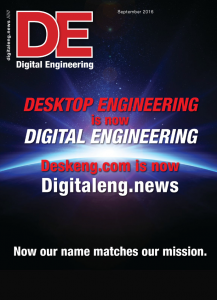
Desktop Engineering is now Digital Engineering
September 1, 2016
You may notice something different about our magazine and websites. After 21 years, we’re changing our name and the look of the magazine—but it’s really still the same DE. We’re not changing the contributing editors you’re used to reading. We’re not changing our mission either. We still exist to bring you the latest news and analysis of technology for optimal engineering design. So why the new look and new name?
Because just about everything else has changed since we launched our first issue in September of 1995. The technology used to achieve optimal engineering design has evolved significantly over the past two decades. The information in our magazine, newsletters, websites, blogs, webcasts, videos and research reports has naturally evolved to follow it. We are now at a point where complexity and connectivity have made collaboration critical to product design and engineering. The desktop is still part of engineering, but it’s the digital thread—the flow of data back and forth throughout the design cycle and product lifecycle—that drives engineering technology today.
Complexity Continues to Grow
The convergence of mechanical and electronic engineering, coupled with embedded software, has blown product and system design complexity through the roof.
Here’s just one example: Ford says the 2016 F-150 has more than 150 million lines of code. To put that in perspective, a smartphone’s operating system has about 12 million lines of code and the space shuttle had about 400,000. Why so much software in a truck? According to the company, it’s part of the Ford Smart Mobility plan to be a “leader in connectivity, mobility, autonomous vehicles, the customer experience, and data and analytics.” Ford says it wants to be an “auto and mobility” company. Hardware is becoming software.
Many companies see technology as a means to redefine what it means to be a manufacturer. And, thanks to the growing popularity of the Internet of Things (IoT) in industrial and consumer products, design complexity shows no signs of slowing.
Connectivity Adds to Complexity
IoT-driven complexity begins by integrating sensors and communications into products—many of which have been strictly mechanical or unconnected in the past. But that’s just the start. The data coming back from all of those connected products can serve multiple purposes, such as showing how and when products are being used, how they can better work together, and how they’re likely to break. The IoT represents a potential gold mine in real-world use data. When collected, filtered and analyzed, it could help you leap past the reliability of previous design iterations and make systems that are even easier to use and maintain.
“Most people think of the Internet of Things as a way to connect, optimize and automate everyday products,” said Jim Heppelmann, CEO and president of PTC, during the LiveWorx 2016 conference. “But we think that physical/digital convergence must expand to include how humans interact with it.”
Collaboration is Critical
To keep pace with the design of complex, connected products requires engineers from different disciplines to work together closely on design, simulation, prototyping and testing. It also requires real-time input from co-workers outside of the engineering department.
That type of collaboration requires a digital thread—a workflow that makes information available in a way that will be embraced by all involved. The thread needs to contain engineering information just as much as it needs information from other stakeholders connected to the product lifecycle. It ultimately needs to connect the people who design and engineer products to the people using those products, and vice versa. That’s not an easy goal to achieve. To get there, the digital engineering technologies used to create optimal designs need to be ubiquitous, so they need to be easier to use, affordable for large and small businesses, and plugged into the wider enterprise.
So that’s why we’re changing our name to match our coverage. You can call it convergence, democratization or the next Industrial Revolution. We call our coverage of the technologies used for optimal engineering design Digital Engineering. We hope you will find it useful.
Subscribe to our FREE magazine, FREE email newsletters or both!
About the Author
Jamie Gooch is the former editorial director of Digital Engineering.
Follow DE




